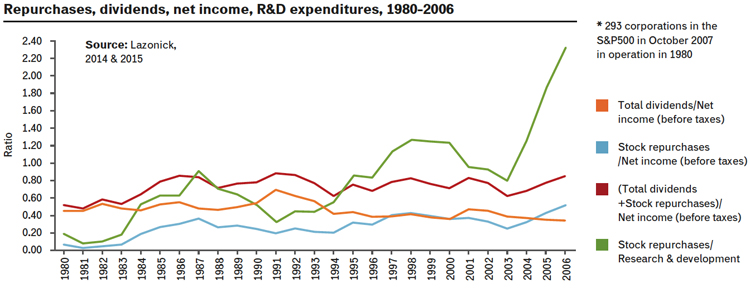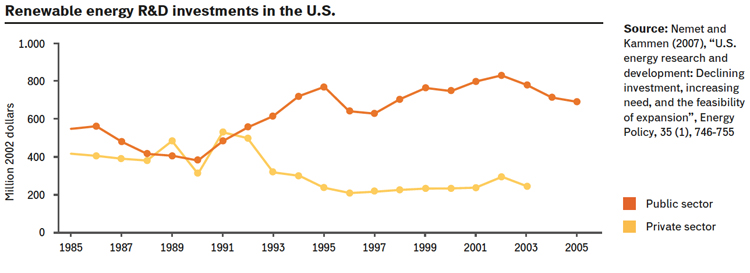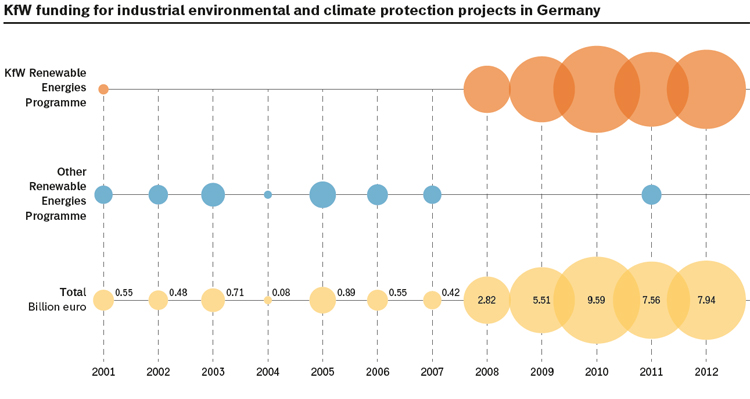
With no intention whatsoever to instigate legends on private companies, Pavan Sukhdev – interviewed in the last issue of this magazine – claims that the main driving force of change behind the current development model should be large multinationals, mainly because of the growing inability of governments to offer the necessary leadership. They can achieve that with certain conditions: aligning their objectives with those of society, limiting the use of financial leverage, communicating effectively and building a vital element in the communities and places where they operate. They will have to become guardians and promoters of financial, natural, social and human capital. Will they manage to do that? The thing is that, according to Sukhdev, corporations can achieve that more easily, quickly and efficiently than governments. A vision that seems to be the exact opposite compared to the argument put forward by Mariana Mazzucato in her book. She debunks the false image of the government as inertia factor, which would slow down the “natural” dynamism of a company, equally directed at innovation. Such image is the result of a distorted perception of how the fundamental innovations that have characterized recent decades originated.
So the first question is: Who is now and who will be in the future the protagonist of sustainable transformation, the so-called green transformation? The State or private companies?
“Neither. I believe the problem is of a different nature: today, we need to accept the current situation or to use both history and theory to build a different State, to aim at another change. We are faced with two fundamental issues: the first is that large companies are overfunded and more engaged in free-riding activities rather than in research and development ones. They repurchase their stock to cause the share value to rise, thus increasing the earnings of shareholders, rather that investing in research and development. Many companies do that, both in the Information Technology sector and in other areas, the worst one being the Energy sector.
The second problem is that there are States and governments lacking the necessary courage to perform again what some governments did in the past. So, on the one hand we have to reform the State, re-instilling courage into it, and on the other the definancialization of large corporations.
So, the question is not between State or corporations, but rather between what type of companies and what type of State.
I am always referring to a mission-oriented State, not a State as “ministry of the economy”, the red tape, a top-down economy. If we consider Silicon Valley as well as nations such as Germany, Denmark and others (perhaps even China), what we see is that wherever there has been smart innovation, there was a so-called decentralized network state, and it is interesting to note what kind of organizations and structures operate in it and what kind of role they played. The other interesting aspect is the role of the State emerging from it: a player that does not merely correct market failures, for example when a public good such as basic research is involved, where private investments are so low that the state must intervene to correct them. This is still a crucial function, indeed the state funded all basic research behind the development of sectors such as IT, nanotechnologies, biotechnologies and now the green sector. Moreover, public funds have mainly been used to develop renewable energies.
Besides all this, the State also played a role in market creation. As it happened in the United States, where as far as the development of renewable energies is concerned, the State created and shaped the market, by intervening along the whole innovation chain, not only within upstream basic research, but also in applied research. And money has also been put into it: initially, capital financing of companies in the renewables’ sector, did not come from venture capitalists, but from “patient capital” from various kinds of public funds. In Israel, for instance, there is a Public Venture Capital Fund; in the US there are many kinds of funds, such as the Small Business Innovation Capital Fund, just to mention one. There has been a great deal of public commitment along the whole research chain, not just in basic research. And it has always been about a mission-oriented commitment. What do I mean by that? That the objective, as was the case for space research, was clear and defined in advance: to land on the moon. While its usefulness (or lack of it) is debatable, and whether they really achieved that mission may still be a big bone of contention, what counts is the model. On the contrary, big challenges tackled by the European Union (population ageing, climate change) often risk being very abstract. They are embraceable challenges, but when can they be achieved? A direction, albeit broadly, must be defined, but it must be realistic, with clear objectives, so that it is possible to know when they are achieved.”

So, private and public investments with regard to innovation are fundamentally different. The State is (or can be) a protagonist when it comes to trigger change processes with a strategic value, as is the case with the green economy, while the private sector comes into play when someone else created favourable conditions to do it and, in the absence of more advantageous ways, to improve its performance.
Going back to the green development, what strategies should a government adopt? What are the key elements to implement its mission?
“Today, to develop a green economy any State cannot merely intervene on market failures, for example through the introduction of a carbon tax, but it must make mission-oriented choices, in the direction of a green economy. In the past, this is what happened: developing the IT sector was a choice, working on nanotechnologies was a choice. Today they need to make a green choice, which does not mean only renewable energy, but a complete economy reorientation. Let’s just take the IT sector as an example: the so-called IT revolution is only half-way through, it has not really spread. As Robert Solow put it: ‘Computers are everywhere but they do not appear in the statistics regarding productivity’. Up until now, the IT sector has had no direction, there was no real orientation towards a final goal. There could be a new green direction in order to achieve that full deployment that, for instance, the electricity revolution has experienced over the last fifty years.
The problem is that we cannot even find the courage to talk about the State in these terms, namely as a subject steering development and innovation. At best, we talk about it as a subject acting to reduce risks for the private sector, by offering incentives, creating private-public partnerships and defining rules and regulations.
It is not a subject that makes brave decisions, many of which will fail. This aspect must also be highlighted, because the State too, in its capacity as a fundamental investor in innovation, can fail. Let’s take as an example what Obama did in 2009: a big part of the stimulus package for the economy was directed towards green policies, with guaranteed loans for green initiatives, such as the $465 million loaned to Tesla and the $500 million allocated to Solyndra. And then what happened? Tesla performed well while Solyndra went bankrupt. What happened to taxpayers funding these initiatives? Nothing, except the costs.
So, by not recognizing that the entrepreneurial State is an investing one accepting a macro-risk (with possible bankruptcies), we will only keep on socializing the risk while privatizing the profits. This creates a big problem, because in this way inequality soars (because, as mentioned above, the profits are not returned to the State, to the people) and money is taken away for the next challenge to tackle. Any venture capitalist chooses to invest in a higher risk portfolio knowing that it will balance it out on safer options. Pretending that the State must only reduce the risks for private companies, relegating itself to a role of administrator and regulator and by doing it in those countries where the state plays this role of investor/innovator in an effective way (which does not happen in Italy), this revolving fund does not happen. Nothing goes back to the State, to the community.
What does such attitude cause in the public opinion? Let’s take the healthcare system in the USA: taxpayers’ total expenditure for drugs is $32 billion, but when Obama decided to bring healthcare to 70 million people which did not have access before, with the so-called Obamacare, he was accused of ‘interfering with our healthcare system’. He defended his actions with the usual leftist arguments, referring to ethical values and justice principles, when he could have rightly said, “Interfering with your healthcare? No, my dears, we created your healthcare system!”. People do not even see the co-creator role of the State, but the drugs they buy have been created by the State (through what has been explained above, namely the funding of some mission-oriented research). There is a problem of ignorance and Obama himself (but the same applies to all national and local politicians) does not even have the right vocabulary, the right words to talk about the State in these terms. And politicians are at a loss even when they are fully aware of the role played by the State.
Of course there is also a worse scenario: when politicians have no words because they fail to understand what has been done. Matteo Renzi the Italian Premier visits Silicon Valley and goes back home with the Jobs Act, without having the slightest idea of the role the State played in the creation of Silicon Valley. The government or the State must create a huge wave above which businessmen and venture capitalists can surf. Today, the State no longer creates this wonderful wave. Not only that. When you create a wave, you must also seal pacts, symbiotic and not parasitic, with the companies. Once again, let’s consider Obama: when FIAT put itself forward to buy Chrysler, Obama, in a nutshell said: ‘Dear Marchionne, would you like to buy Chrysler? Fine, since taxpayers rescued Chrysler, I tell you what to do, you must invest in hybrid engines’. So, FIAT in the USA invests in hybrid engines and in Italy, what does it do? Nothing like that, of course. But has anybody asked? Of course not. Renzi’s policies see the State as a mere facilitator for the private sector: would you like fewer taxes? No problem. What law bothers you? I can repeal it. And all that without any evidence that this can benefit the community. Think of the Jobs Act: it would have been beneficial for citizens if the Italian companies had on average 13-14 employees, by recruiting more and exceeding 15 they would have benefited from this law. But in actual facts the average number of employees in the Italian companies is 4! So this has just been an unconditional gift to large companies. The obstacles to growth did not depend on workers’ rights, but on the lack of a serious ecosystem, made both of public and private investments. In Italy the relation between the public and private sector is parasitic. They are both inert, so public, private or the subsidiarity of the third sector have nothing to do with it. I consider the third sector inert too, a stopgap, not a subject leading to the opening of new markets. Just as the State does when, with regard to health, sponsors the research of new drugs rather than promoting new lifestyle models!”

But over the last decades a contradiction has emerged: the public policy has delegated hugely to economy. And the economy has delegated a great deal to monetary economy. Political choices are increasingly taking into consideration aspects linked to factors strictly associated with their monetary value.
Pavan Sukhdev reminds us that a great deal of natural capital, and therefore of common good, is linked to factors with no clear monetary value. So, is there any risk that this “cultural conversion” of public policies makes them unable to see the priorities of sustainability? Is there a possible difference between centralized State and the so-called decentralized State? How not to lose the visibility of common good, thus orientating the project, research, technological innovation in the interest of the community?
“First of all when I talk about a decentralized State I don’t necessarily refer to different geographical levels of government (national or regional, for instance) but to a system like the US one, where all the competences on a certain theme, energy for example, are not concentrated in a specific ministry, but are distributed over many kinds of agencies and organizations. Then we can also look at whether they are federal, governmental or local, but this is not the point. Let’s take ARPA-e: this agency is committed to transferring to the field of renewable energies that out-of-the-box thinking and to carrying out that function that DARPA did before the Internet came along. It is a federal agency and it is decentralized from an organizational point of view; if you go inside it you’ll have the impression of being inside Google HQ: same creative atmosphere and not only that. They managed to recruit the best brains. The head of the agency himself was a Nobel Prize winner. Because what is interesting is that when you have a mission-oriented public agency it becomes an honour to work in it. If, on the other hand, you are there just to facilitate the work of the private sector, to de-risk, if you are a real scientist, you have no motivation to work there.
Secondly, regardless of the territorial distribution of an institution of this kind, what is important is to understand its organization. This also applies to Italian history; suffice to think of IRI’s (Institute for Industrial Reconstruction). Here, it appears clearly that the question is not so much whether we need IRI or not. If we look back in history, when did IRI play an important role? How was it organized, who worked in it, what were their contracts like? For example, within DARPA employees had a five-year contract. You are employed and are pushed, I am not saying to go bust, to do difficult things and then you are appraised not just on how successful you were, but also for the risks you took.
The other thing is that nowadays we are going through very distorted times: the austerity policies are indeed causing an exactly opposite phenomenon, one of growing centralization. Take as an example what is happening with the Cameron government in the United Kingdom compared to what the Big Society Project was: the first thing he did was to quash QUANGOS (the acronym stands for Quasi-Autonomous Non-Governmental Organisation, editor’s note) such as Carbon Trust, which was very interesting – and is still operating today, although weakened – and acted as a public venture capital fund for energy. This was one of the first things they cut down on. David Cameron’s government, with all its austerity policies, is not just about the reduction of social expenditure, but also its growing centralization, reducing such diversity of decentralized organizations and producing a less important image of the public sector (therefore less interest to go and work in such organizations).”
So, in your opinion the key element within such dynamic and project-based public sector is represented by its own variety and multiplicity. Does centralization constitute its end?
No, this is not the point. The question is not centralized or decentralized. Anyone wishing to innovate needs patient capital. The way in which direct patient capital has been created worldwide, that is supplied directly by actors appointed to do that (which does not happen in Italy) is different: in Germany, as well as in China, they achieved this through a large public bank; in the USA they did it differently. In Finland, there is on the one hand a very big central public agency for innovation (Tekes, national agency for innovation financing) and Sitra (Finnish Fund for innovation) which is a peripheral agency. Both things are needed. So, in order to create a dynamic and flexible fabric what is really needed is a multiplicity of organizations, this is the key factor. And such dynamism and multiplicity play a very important role for the private sector, which becomes inert if it does not measure itself against its public counterpart and, in the long run, they both become inert.
The other aspect is how to assess, especially when it comes to public goods. What is a public good? The public good is a market failure: it is produced when there is something that can hardly generate profits, with an ensuing underinvestment by private companies. It is like with nuclear fusion: why does a private company not carry out nuclear fusion? Because if and when nuclear fusion will be invented it will be impossible for a company to appropriate such basic invention that it will be used by everyone. An invention whose potential spillover effects are so huge that cannot be included in any company’s portfolio.
The thing is that public funding alone was never able to let us have such general-purpose technologies, such as the Internet or electricity, nanotechnologies, biotechnologies, which have spillover effects, repercussions over the whole economy. Basic research was never enough, but there have always been upstream choices not only about public goods, but also about participation in the whole innovation chain. And this is how the problem is assessed: when we deal with public goods, the assessment issue should not even come into play: the aim is open access (on this subject we are experiencing a setback at the moment), so invest while you can because you know you will have huge returns. But this is not enough, since applied research is also needed – a great part of which, as it is normal, is bound to fail – it is necessary that such patient capital go to the very few companies seriously interested in innovation, taking into account the fact that they may also go bankrupt (as the above-mentioned Solyndra). Here one should wonder whether it is legitimate to monetize, to speculate whether the State can make a profit out of it, as well as lose out. We cannot pretend, as it happens with basic research, that this is irrelevant because the returns will be so many and so varied that citizens will benefit from them.
My point of view is that by not admitting that the State plays the role of entrepreneurial State, we did not accept that the public party, namely the community, could benefit from this downstream innovation so the process, at some point, will stop. This is brought about by the fact that we no longer have a taxation system such as that that allowed, for instance, the creation of NASA: during Eisenhower’s presidency (who was a republican and a soldier by the way), taxation for the most affluent, the upper marginal rate reached 93%!
Over the years this taxation system has been phased out, such resources are no longer there, so today time has come to wake up and do like Israel that keeps equity in some of these strategic investments. In other cases the tool can be a golden share on patents. Maybe not forever, but perhaps until the State decides to play his role as entrepreneur, not leaving all the profits to the private sector. Or a loan system could be adopted, as it happens with university students in the UK: the government lends you money to develop your curriculum. Can’t find a job after graduation? You don’t have to give me back any money. But if you can, you pay back your debt.”
Must the entrepreneurial State thus build a clear “social pact” (or a political one, if you will) with private companies?
“Absolutely, and it can be a very simple one, like the one mentioned above, an agreement to reinvest the profits made. This is precisely what is needed. There is no need to talk about a New Deal, but just about any deal will do, that’s what we need. Exactly like Obama did with FIAT or as it happened with AT&T in the telecommunication sector. Today, big corporations show record levels of immobilized resources, which are not reinvested.
A similar tool should be part of an innovation policy, so we should wonder what kind of private company we need, for example for the innovation of economy in a green direction. Going back to the USA, we know that small companies do little innovation, so the issue to tackle would be: what kind of relations with large corporations can be useful to the very few small companies really interested in innovation? It is necessary to definancialize large corporations, thus helping the very few small companies committed to this aspect. The aim is to create an ecosystem like that in Germany, where they are investing greatly and where such ecosystem benefits from a mission-oriented public bank (KFW) and a fabric of independent research agencies (such as the 60 institutes within the Fraunhofer Gesellschaft) supporting and directing the innovation process.”

The image of a State as “innovation retarder” is particularly strong in Italy. And many recent governments have done their best to validate it. By contrast, in some key sectors of sustainable innovation, such as the bioeconomy, companies are the driving force. Some EU directives managed to “impose” long-term strategies which otherwise would not be there, supporting the most advanced sectors of private companies.
Currently – thinking about the way the European Union is addressing the Greek crisis – it may seem an inappropriate question, but could the supranational institutions such as the EU carry out such entrepreneurial driving force towards strategic innovation better than national governments?
“Of course! Provided this institution does not cause problems itself. To tackle the crisis and abide by the parameters required by the EU, since 2009 Spain cut public funds for innovation by 40%. Then, you may have Horizon 2020 that dishes out 80 billion for innovation, but meanwhile you have strangled that agency network, that decentralized actors’ ecosystem, which is vital to implement processes. And who can work in moneyless agencies? If you are a good scientist, are you happy working there? Of course not! You go and work for Bill Gates!
So, there is a need for a combination of both a national and supranational plan, which must operate consistently, though. Multiplicity is a positive factor, but today, in Europe, supranational forces are operating in the opposite direction: funds to Horizon 2020 – the main EU research programme aimed at sustainable innovation – are being reduced, in order to fund the Juncker Plan of investments in infrastructure and... research! So much for consistency…”
For more information see the volume by Mariana Mazzucato and Caetano C. R. Penna Mission Oriented Finance for Innovation, available online tinyurl.com/pl7yvmm



